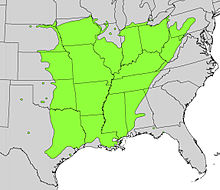Honey Locust
| Honey locust Gleditsia triacanthos |
|
|---|---|
 |
|
| A honey locust in Washington state shows its fall color. | |
| Scientific classification | |
| Kingdom: | Plantae |
| (unranked): | Angiosperms |
| (unranked): | Eudicots |
| (unranked): | Rosids |
| Order: | Fabales |
| Family: | Fabaceae |
| Genus: | Gleditsia |
| Species: | G. triacanthos |
| Binomial name | |
|
Gleditsia triacanthos L. |
|
 |
|
| Natural range | |
The honey locust (Gleditsia triacanthos) also known as the thorny locust, is a deciduous tree in the Fabaceae family, native to central North America where it is mostly found in the moist soil of river valleys ranging from southeastern South Dakota to New Orleans and central Texas, and as far east as eastern Massachusetts. The species has become a significant invasive weed in other regions of the world.
Honey locusts, Gleditsia triacanthos, can reach a height of 20–30 m (66–98 ft), with fast growth, and are relatively short-lived; their life spans are typically about 120 years, though some live up to 150 years. They are prone to losing large branches in windstorms. The leaves are pinnately compound on older trees but bipinnately compound on vigorous young trees. The leaflets are 1.5–2.5 cm (5⁄8–1 in) (smaller on bipinnate leaves) and bright green. They turn yellow in the fall (autumn). Leafs out relatively late in spring, but generally slightly earlier than the black locust (Robinia pseudoacacia). The strongly scented cream-colored flowers appear in late spring, in clusters emerging from the base of the leaf axils.
The fruit of the honey locust is a flat legume (pod) that matures in early autumn. The pods are generally between 15–20 cm (6–8 in). The pulp on the insides of the pods is edible, unlike the black locust, which is toxic. The seeds are dispersed by grazing herbivores such as cattle and horses, which eat the pod pulp and excrete the seeds in droppings; the animal's digestive system assists in breaking down the hard seed coat, making germination easier. In addition, the seeds are released in the host's manure, providing fertilizer for them. Honey locust seed pods ripen in late spring and germinate rapidly when temperatures are warm enough.
...
Wikipedia
